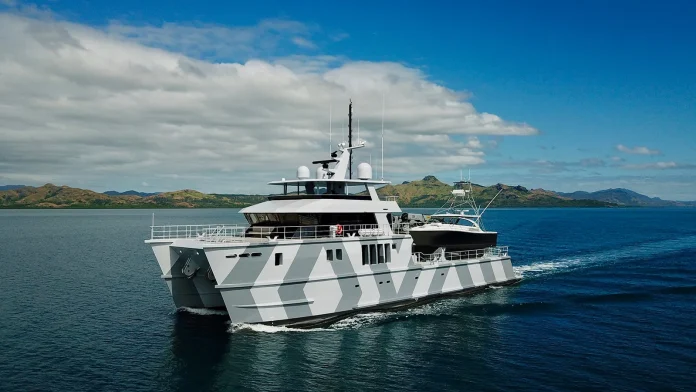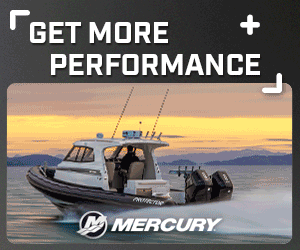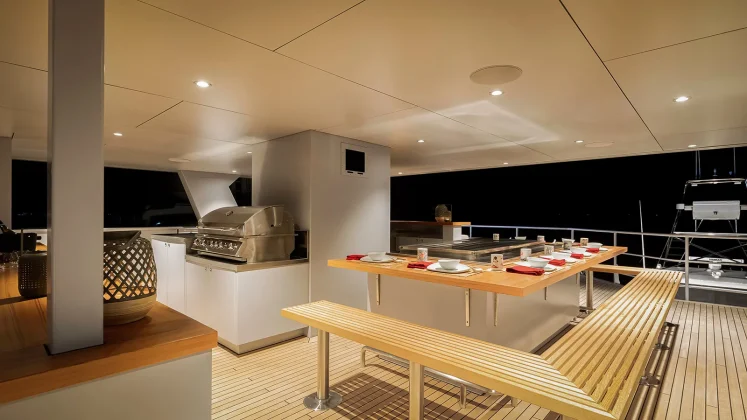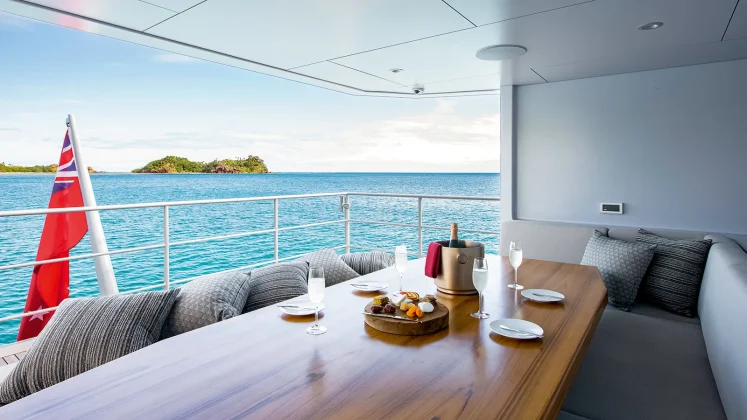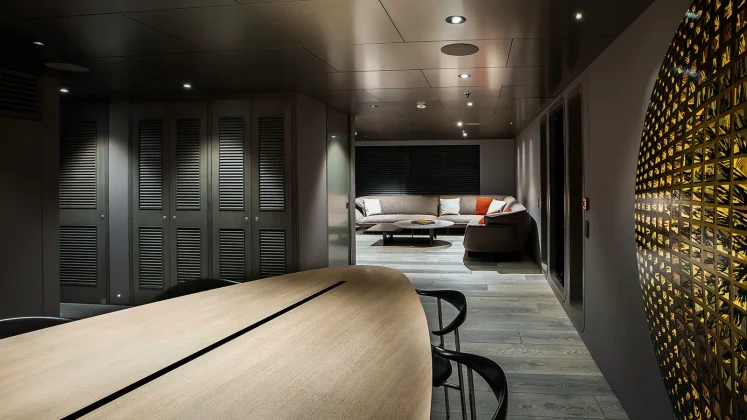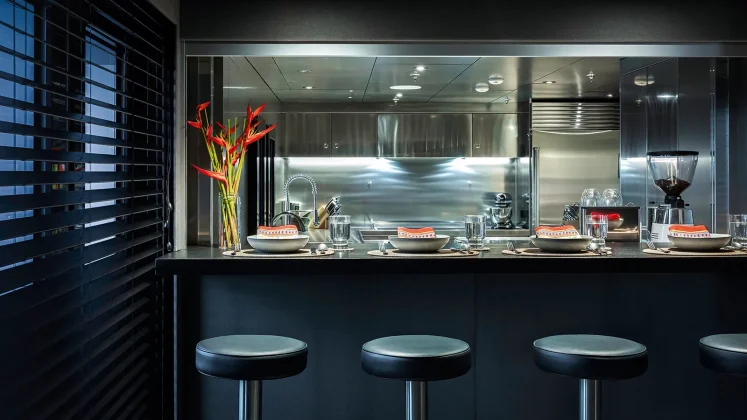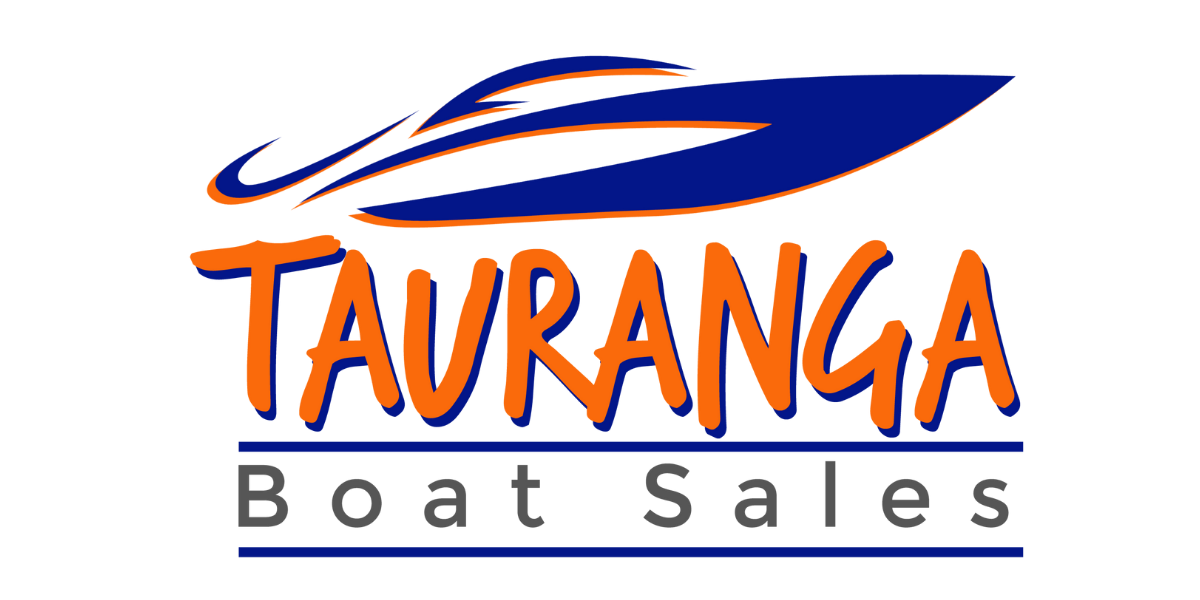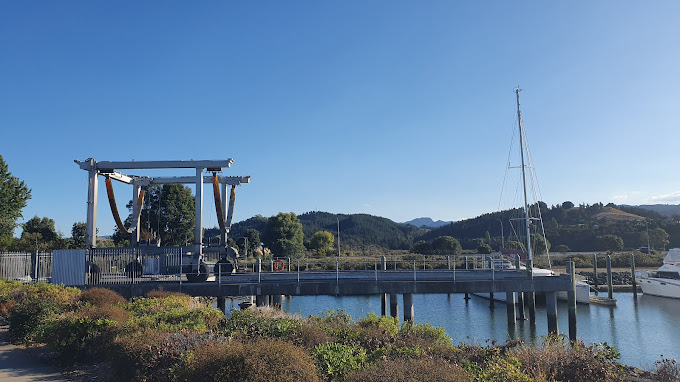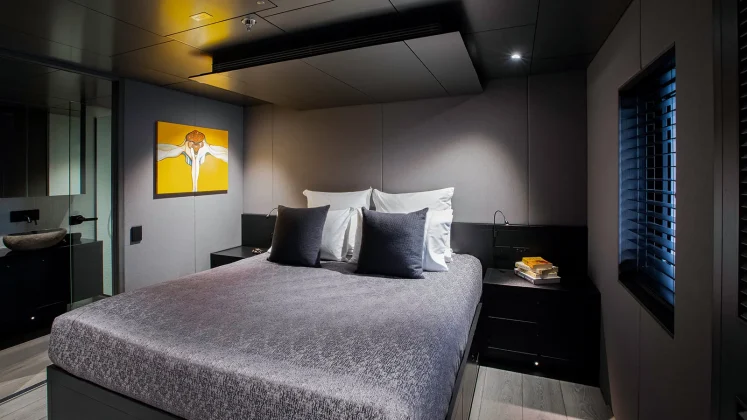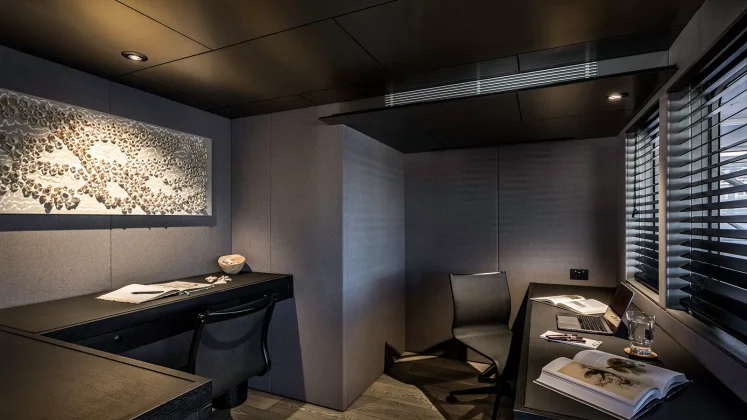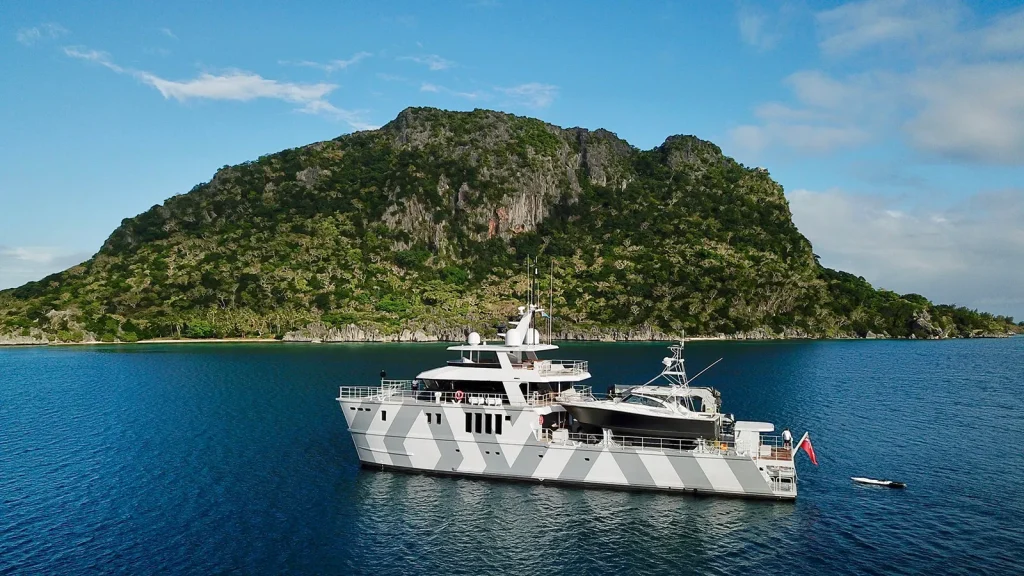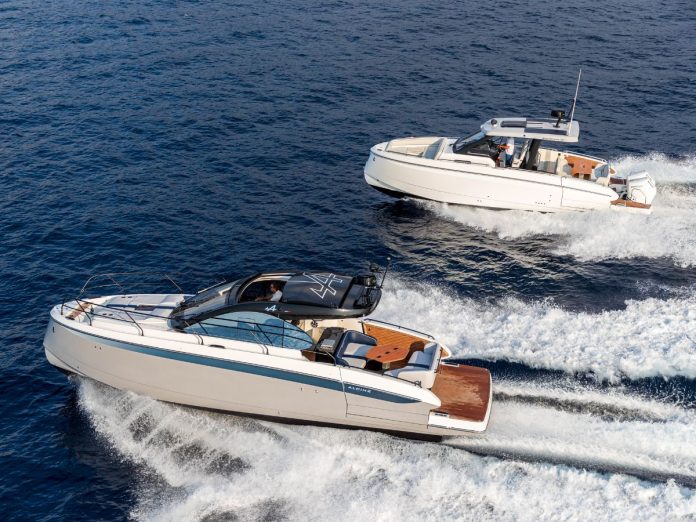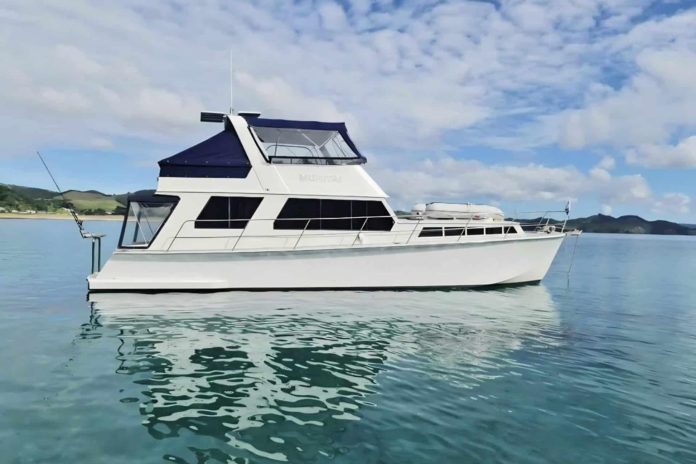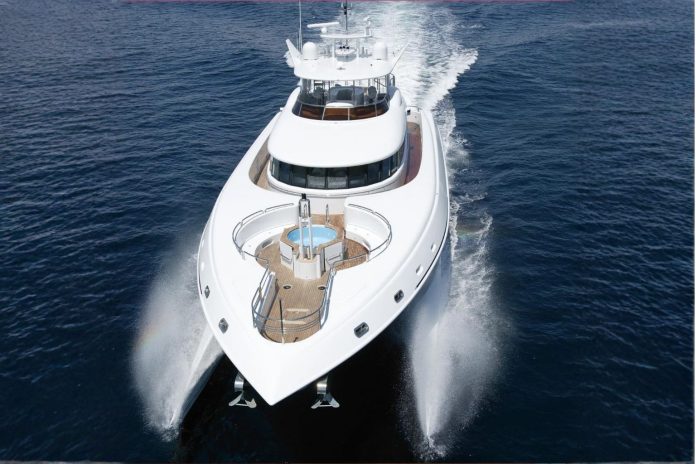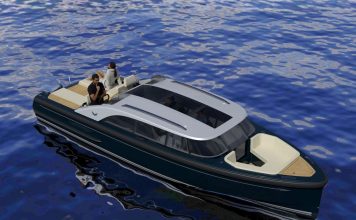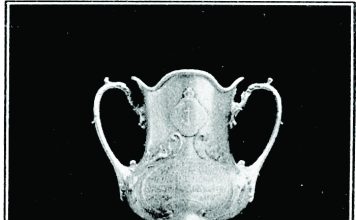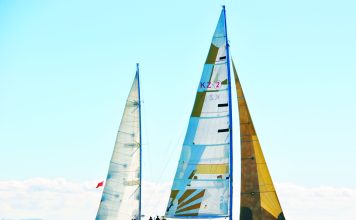Built to go places
The 2019 build, The Beast, is not your usual motor yacht. At 39.2 m (128′7″) and a 12 m beam, she is a true expedition motor catamaran. And she’s Kiwi through-and-through. The design and build were handled in New Zealand by Auckland-based naval architect and boat designer, LOMOcean, and Palmerston North-based, Design Profab Central Engineering.
One of the critical design decisions was to go aluminium twin-hull, giving a draft of just ~2.5-2.6 m and the interior volume of what might be a 50-metre monohull, yet staying under 500GT. This means boaties familiar with New Zealand offshore cruising can appreciate the stability, deck space and access into more sheltered anchorages.
The practical real‐world capability are interesting: cruising speed around 11 knots, top ~13 knots, and a listed range from 4,000 up to 7,000 nautical miles (depending on conditions) thanks to a large fuel capacity (~70,000 L) and commercial-grade systems.
That kind of autonomy opens up Pacific crossings, sub-Antarctic legs or remote South-Pacific atoll exploration, not simply “weekend around the gulf or Sounds” (although while we’ve been out on our sailboat, we have spotted The Beast a number of times in waters closer to home.) For Kiwi skippers, that means serious gear, serious prep, and serious cost.
Gear-up for genuine adventure
What stands out is how The Beast isn’t just “luxury cruising” but purpose-built for remote operations. The tender and toy inventory reads like an offshore adventure catalog: a 13-metre sport-fisher (“Baby Beast”), a 9.3-metre amphibious tender for beach landings, a 4.5-metre Zodiac RIB, multiple kayaks, paddleboards, wakeboards, a Schiller bike (a human-powered, pedal-driven watercraft), and a dive-centre with 12 full sets and compressor.
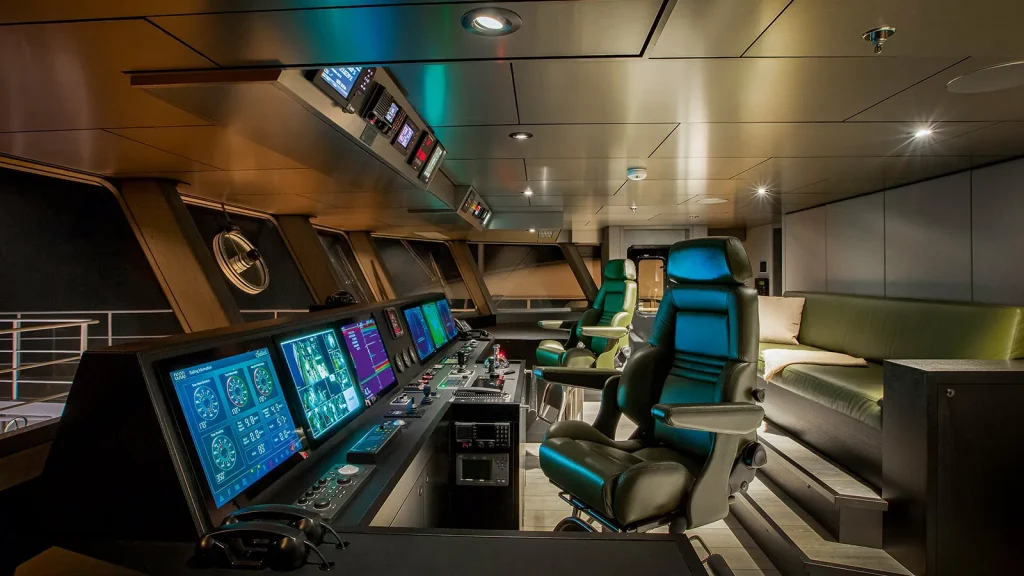
On board refuelling facilities for tenders add extra flexibility. For boaties who’ve longed to anchor off un-tracked coves, drop the amphibious tender and step ashore, The Beast delivers. The flip side: you’ll need a well-trained crew, maintenance commitment and expedition logistic mindset.
Life on board: comfort meets commercial grade
Though built for rugged terrain, The Beast does not skimp on comfort. Five staterooms for up to 12 guests, an owner’s full-beam suite forward, large social zones, outdoor dining, a teppanyaki grill on the sun deck and lovingly crafted interiors by Oceania Interiors of Auckland show that “expedition” needn’t equal spartan.
The Beast‘s operating scale is not insignificant: commercial-style systems, large crew complement (nine for the guest complement), and infrastructure suitable for global cruising.
The stability of twin-hull form means less heel, more space, and for tricky anchorages around NZ islands that matters.
Accommodation and social spaces
Inside, The Beast is laid out for comfort as much as capability. Across her 39-metres length / 12-metre beam, every space has been planned to make long voyages feel effortless.
The main deck houses a broad, open-plan saloon and dining area with wrap-around glazing and direct access to the galley. Guests can sit at a breakfast bar while the chef works in a professional-grade kitchen; a design that suits both private use and charter operations. The main dining table comfortably seats twelve, backed by soft lounges and a full-height TV wall for movie nights or briefings.
Moving aft, a covered outdoor dining zone doubles as a day lounge, sheltered by the deck above but open to the sea air. It’s a favourite breakfast spot, large enough for the full guest complement.
Above, the sundeck/flybridge carries a teppanyaki grill, a wet-bar, and another dining setting under a partial hardtop. There’s room for casual dining or entertaining under way — a space used as much for evening meals as for watch-keeping in good weather.
Down below, the lower lounge provides another quiet area for reading or retreat. Together with the three exterior dining areas, it ensures guests have multiple choices to gather, eat, or relax without crowding each other.
The yacht’s five guest cabins sleep up to twelve. The full-beam owner’s suite sits forward on the main deck with panoramic views and its own en-suite bathroom. Two king-berth cabins occupy the lower deck amidships, each with en-suite, while a convertible twin/king cabin and a four-berth bunk cabin round out the accommodation, ideal for family or crew overflow. Every cabin has a private en-suite and independent air-conditioning.
For crew, there are four cabins (sleeping nine) and a dedicated crew mess adjacent to the service galley.
In all, The Beast offers three outdoor dining areas, two interior lounges, one professional galley, five guest cabins, and nine crew berths — a practical balance between expedition toughness and live-aboard comfort.
Why the sale? What it means for Kiwis
The Beast was commissioned by Sir Michael Hill, a well-known New Zealander who passed away in July 2025 at age 86. His death may be a motivation for the listing, though publicly the boat is simply “for sale”.
For Kiwi boat-owners the sale is significant: an iconic NZ-built craft is on the global market and presents both a benchmark and a unique opportunity.
For those in the market, points to consider: the scale of operations is massive, fuel, crew, maintenance, yard‐time. The twin-hull aluminium build is rare and may require specialist support. Yet the upside is a craft capable of true exploration. For the New Zealand marine industry, The Beast showcases domestic capability at the top end, reminding the industry that we compete globally.
The yacht is currently listed through Ikonic Yachts in the US, with an asking price of USD $14.5 million. It’s also managed by 37 South Yachts for charter, where rates start around USD $215,000 per week.
Ready for her next adventure
Specifications — The Beast
| Builder | Profab Central Engineering Ltd (Palmerston North, New Zealand) |
| Naval architect | LOMOcean Design Ltd (Auckland, New Zealand) |
| Interior designer | Oceania Interiors (Auckland, New Zealand) |
| Year launched | 2019 |
| Construction | Aluminium hulls and superstructure |
| Classification | Bureau Veritas |
| Length overall (LOA) | 39.2 m (128′7″) |
| Beam | 12.0 m (39′4″) |
| Draft | 2.5–2.6 m (8′2″–8′6″) |
| Gross tonnage | 493 GT |
| Engines | 2 × Caterpillar C32 ACERT (1000 hp each) |
| Propulsion | Conventional shafts, five-blade props |
| Fuel capacity | ≈ 70,000 L |
| Water capacity | ≈ 16,000 L |
| Range | 4,000–7,000 nautical miles |
| Cruising speed | 11 knots |
| Maximum speed | 13 knots |
| Guests | Up to 12 in 5 cabins |
| Cabin configuration | 1 Owner’s suite (main deck), 2 king cabins (lower), 1 convertible twin/king, 1 four-berth bunk cabin |
| Bathrooms | 5 guest en-suites + day head |
| Crew | 9 (4 cabins) |
| Dining areas | 3 outdoor (aft deck, upper deck, flybridge) + 1 indoor formal dining + galley bar |
| Lounges | 2 interior (main and lower) + multiple deck lounges |
| Galley | Professional-grade with breakfast bar |
| Tenders & toys | 13 m sport-fisher Baby Beast; 9.3 m amphibious tender; 4.5 m Zodiac; 4 single + 2 double kayaks; 2 SUPs; water-ski gear; wakeboard; Schiller bike; dive centre with 12 sets and Bauer Poseidon compressor; onboard refuelling for tenders |
| Broker | Ikonic Yachts (asking price USD 14.5 million) |
| Charter agent | 37 South Yachts (from USD 215,000 per week) |








